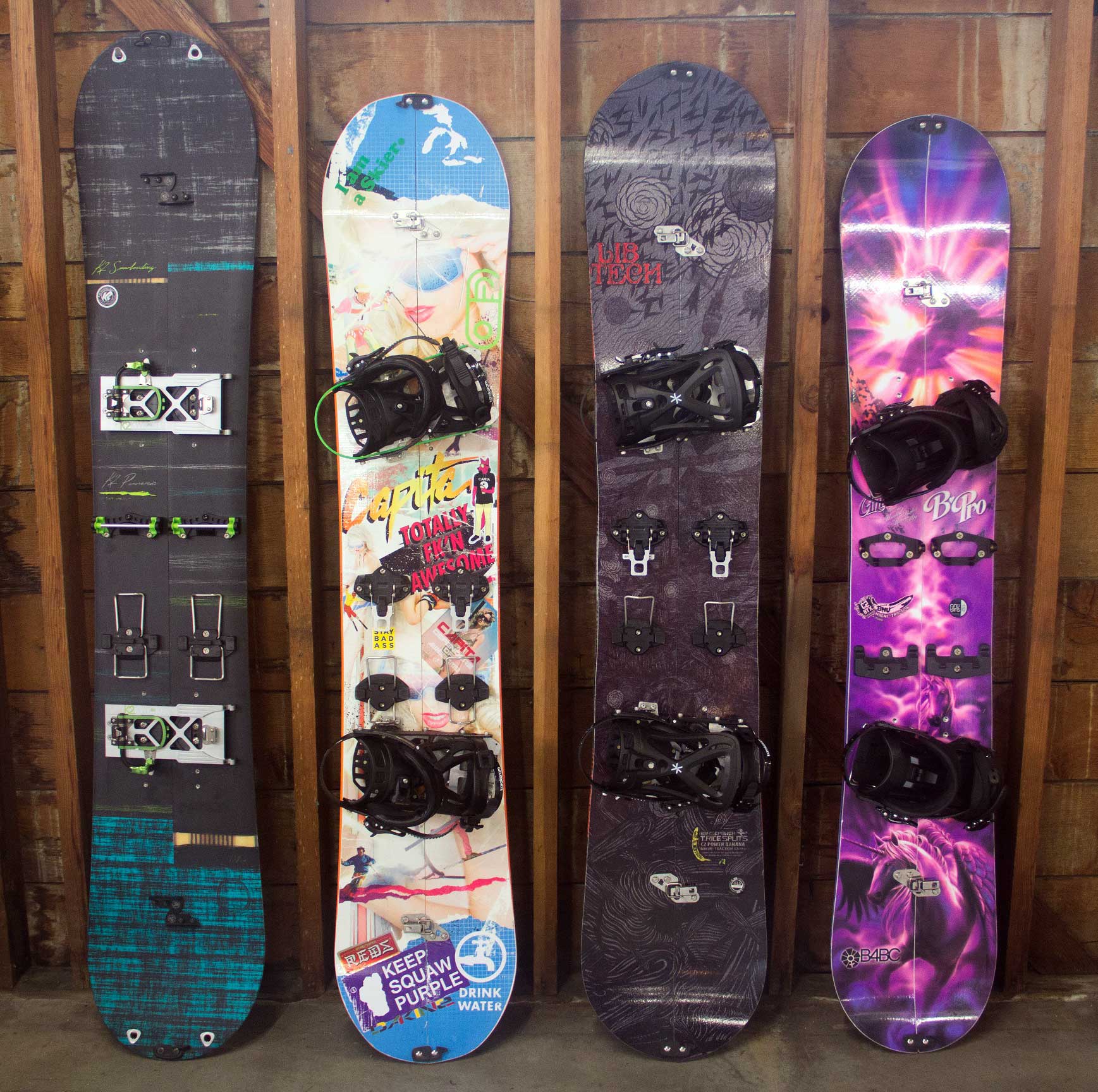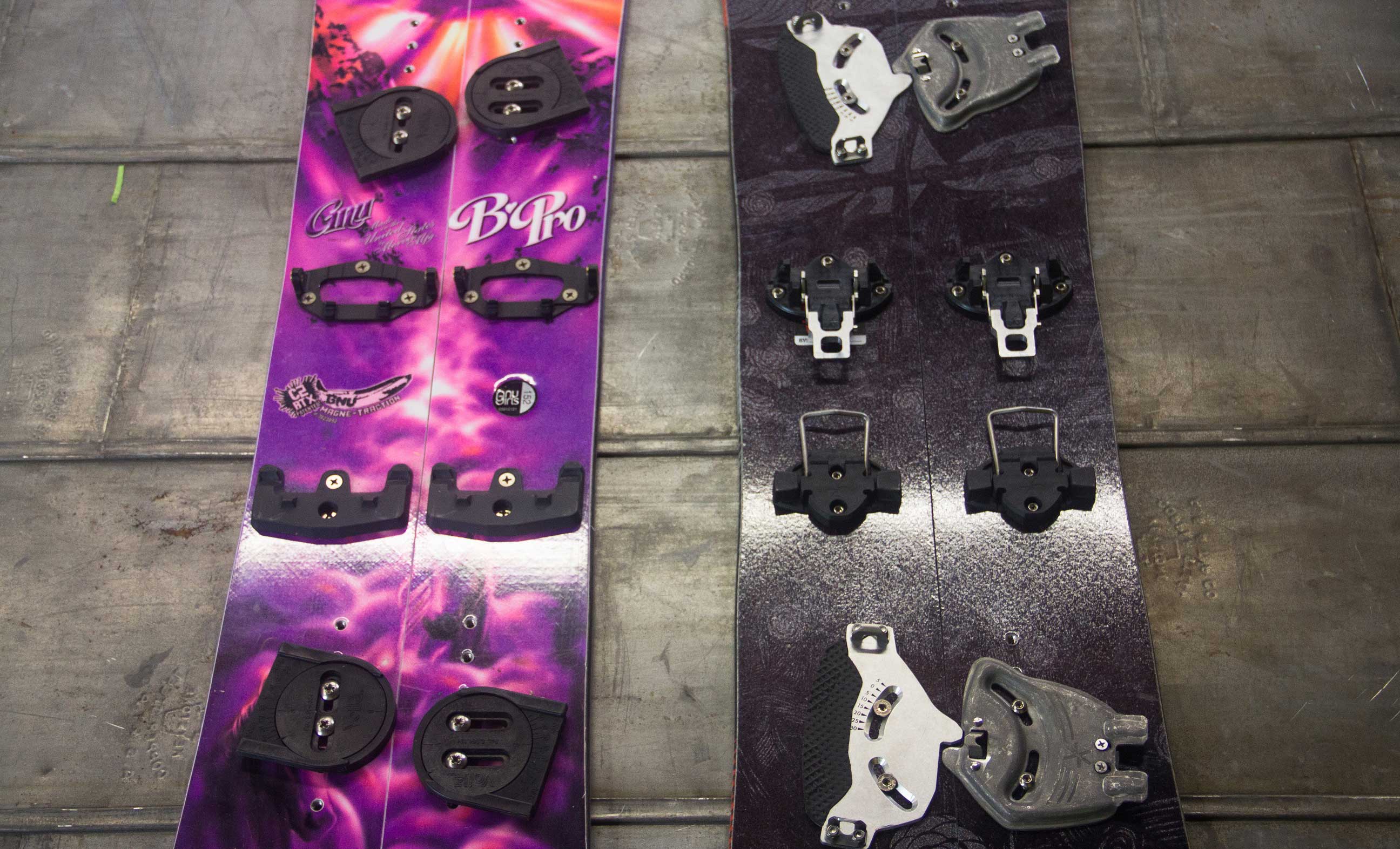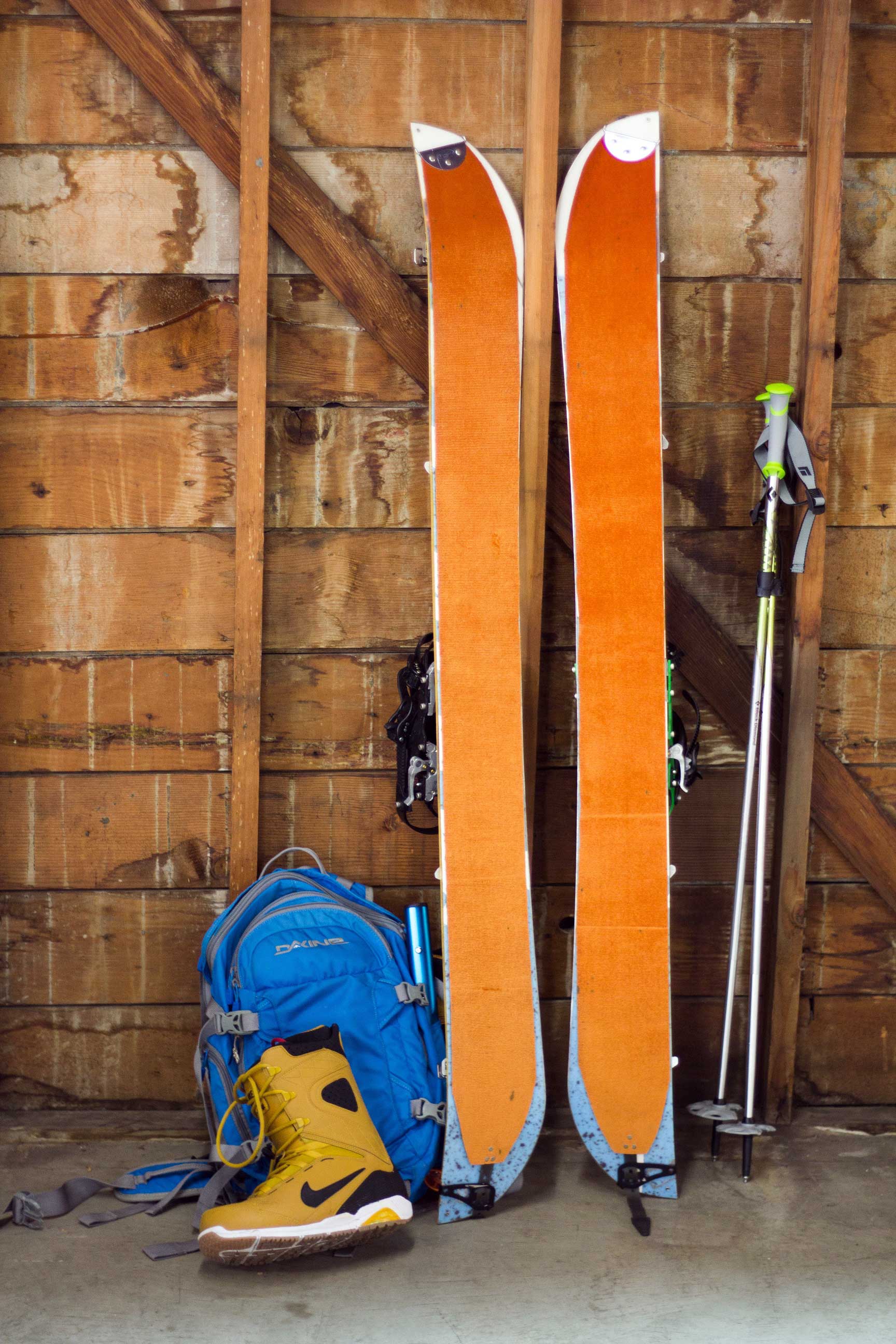How to Get Started Splitboarding & Splitboard Gear Guide
What is Splitboarding?
Sick of lift lines on pow days? Ready to explore the vast backcountry in search of the perfect line? Taking on the challenge of earning your turns all year long? If you answered yes and you don’t want to give up the freedom of riding a snowboard, welcome to the wonderful world of splitboarding.
A spiltboard is a snowboard that has been cut in half vertically to make two “skis.” By attaching special bindings and grippy climbing skins for traction, you can use these skis to hike uphill in the backcountry. Once you have reached your desired peak and spot a good line, attach the skis back together and you’ve got a board to shred down a pristine (and hopefully powder filled) run. Splitboarding is the snowboarder’s key to accessing backcountry terrain.
What Safety Information do I Need to Know Before Going into the Backcountry?
Riding backcountry terrain is one of the most rewarding things you can do on a snowboard, but there are inherant risks and these should be taken seriously. Before you head out into the backcountry, you need to be prepared with the proper knowledge and tools to keep you, your partners, and other backcountry users safe. This means proper avalanche education, basic first aid skills, and knowing how to use your gear. If you don't feel confident in your backcountry skills, look for certified classes or professional guiding services to help you learn and enjoy the mountains safely. Check out the backcountry guides below to help you get started:
What is a Splitboard? How do They Work?
While the concept might seems strange at first, a splitboard is exactly what it sounds like - a snowboard that can be split in half and put back together. Paired with special binding systems, this means you can split your board in half and walk uphill, then reassemble your board to descend like a normal snowboard. No heavy, awkward, and inefficient snowshoes needed here!
There are heaps of splitboards available now, with manufacturers making splits in shapes and sizes for every type of rider. While some riders choose to go the DIY route and make their own splitboard out of a solid board they already own, factory-made splitboards have many advantages. With a sealed inside edge, factory inserts and pre-installed clips, factory splits are ready to handle anything you can throw at them, and you don't have to hack apart your favorite board.
If you're handy, have the right tools, and are motivated to take on the challenge, you can try building your own splitboard with a do-it-yourself kit sold by Voilé or Karakoram. Using a skill saw, electric drill, and a can-do attitude, you can turn your favorite snowboard into a killer backcountry tool. While not for the faint of heart, splitting your own board allows you to choose your desired shape, camber profile, and flex. That said, these days there are so many splitboard options on the market that it's easy to find something to fit your criteria. (Note: When you cut a board in half, you often lose some of the properties that may have drawn you to it in the first place, like stiffness and torsional flex. Take this into consideration when contemplating a DIY split!).
How to Choose a Splitboard
Choosing the right splitboard is similar to choosing a normal snowboard: you want to pick a board that suits your weight, ability, riding style, and the terrain you will be riding. Consider that you will be taking this board on different terrain than you would take your regular snowboard. There are no groomed runs in the backcountry. Similar to regular snowboards, splitboards can be broken down by their intended use and the terrain that they're best in. Keep in mind the snow in the backcountry can be quite variable, so lean towards a more versatile shape until you figure out what might suit you best.

Splitboards of all shapes and sizes, for everyone!
Powder Splitboards
Searching for untouched winter pow? Size up and find a board with some form of rocker; doing this will allow for more float in deep snow. A board with a tapered tail is a great option as well because it allows the tail to sink into the snow and the nose to rise above.
Freestyle Splitboards
Freestyle fun? Look for something that is twin shaped for riding switch. While you don’t necessarily need to size up, it may help if you plan on getting tricky in the pow. Boards based off of freestyle classics or DIY splits are a great option here.
Freeride Splitboards
Turns all year? In search of gnarly lines? Directional and stiff are your friends here. Look for something with some camber under your back foot for maximum power and control and rocker in the nose to stay afloat in deep snow.
Women's Splitboards
Don’t feel like you have to compromise and buy a smaller men’s board. Most companies offer women's specific splitboards, with narrow waist widths, smaller sizes and softer flexes designed for you. From freeriders to freestylers, there are many different shapes and camber profiles to accomodate different styles of riding.
Splitboard Binding Interface
The interface is what connects the bindings to the splitboard for both touring and riding. There are two main interface systems: the Voilé puck system and the Karakoram system. Each has its pros and cons.

Voilé puck system on the left, Karakoram system on the right.
Voile Splitboard System
The Voilé Puck system consists of four pucks that are attached to the inserts. For ride mode, the bindings slide over the pucks and are locked into place with a pin. In tour mode, that same pin creates a pivot point, allowing the heel to be free for longer strides.
There are a couple of different bindings that will work with this system. Splitboard specific bindings designed by Spark R&D, Voilé, and Union's Expedition Splitboard Bindings will work with the puck system. If you don’t want to opt for split specific bindings, the Voilé Sliders allow you to use your traditional bindings while splitboarding. The Voilé pucks are not included when purchasing bindings.
Karakoram Splitboard System
The Karakoram system is designed to work with only Karakoram bindings. It consists of four metal plates that join the splitboard together using the bindings’ lever and pin system. This active joining technology creates a feeling similar to a solid snowboard. In tour mode, the toe piece of the binding locks into the touring bracket, and with its sleeved axel, it creates a pivot point necessary for touring. This interface also allows you to lock the heel of the binding, which allows for side-stepping gnarly terrain and skating out of flat areas. The Karakoram interface is included with all Karakoram bindings, which is reflected in their pricing.
Splitboard Bindings
Although using your regular bindings in conjunction with the Voilé system is an option, we highly recommend investing in a pair of splitboard specific bindings for several reasons. Because splitboard bindings are specifically designed for backcountry use, they are generally lighter and more durable than regular snowboard bindings. Aircraft grade aluminum and carbon fiber are materials Karakoram and Spark R&D both use in their binding manufacture for durability and weight savings. Splitboard specific highbacks allow for increased range of motion while going uphill, and low profile designs reduce hang ups when striding. Furthermore, these bindings often tie into their corresponding interfaces with obvious benefits. For example, Karakoram, Spark R&D, and Union offer bindings that allow you to lock the heel and skate, and also feature an incredibly simple and easy to use riser system. Finally, binding / interface compatibility typically reduces transition times when swapping from skinning to riding, or vice versa.
Splitboard Hooks and Tip & Tail Clips
Split hooks are designed to help hold the two halves of the splitboard together and provide increased torsional stiffness. Tip and tail hook clips are small plastic pieces that connect at the tip and tail. These play an important role in creating a supportive and solid feel, comparable to a normal snowboard. Split hooks and tip and tail clips are almost always included with factory splitboards. Karakoram and Voilé offer their own versions of split hooks.
 Karakoram Hooks (left) vs Voilé Hooks (right)
Karakoram Hooks (left) vs Voilé Hooks (right)
Splitboard Crampons
You never know when you’ll need crampons. They may sit in your pack for weeks, but once you hit that last icy peak, you’ll be glad you packed them. Instant traction in slick situations is never something you want to take for granted. Every major splitboard binding manufacturer produces a crampon that is compatible with their bindings. The crampons usually attach to the touring pivot point and float to provide a smooth glide followed by supreme traction.
Splitboard Climbing Skins
Arguably the most important part of the splitboard setup, climbing skins provide the traction necessary to tour uphill. Skins are strips of adhesive-backed fabric with tiny hairs pointing towards the tail of your splitboard. The hairs of the skins allow easy glide forward but prevent the board from sliding backwards in tour mode. Climbing skins attach to the board with adhesive glue, tip clips, and sometimes tail clips. Most skins are trim to fit, meaning that you have to cut both edges of the skin to match the sidecut of the snowboard. However, more companies are offering pre-cut skins for their splitboard lineup. Manufactured by companies like Voilé, K2, and Spark R&D, skins are a necessity for any splitboard setup. Remember, climbing skins made for skis will not fit splitboards! Purchase splitboard specific skins for proper coverage.
 #evocrew Stew Langner's splitboard setup, with skins attached
#evocrew Stew Langner's splitboard setup, with skins attachedSee our Climbing Skins Guides for more information:
NB: These guides were written with skis as the primary example. When reading, interpret a 'ski' as one half of your splitboard!Splitboard Packages
Feeling a little overwhelmed? Don't worry, that's perfectly normal. It's a lot to take in! If you're intersted in picking up a fully dialed setup that is 100% compatible and only requires assembly, check out our selection of splitboard packges below.
Splitboard Poles
I’m a snowboarder, what do I need poles for? While many snowboarders have little experience skiing, poles are a must for skinning up the mountain. They provide balance (trust us, you'll need it) and let you push with your arms when travelling over flat or rolling terrain. Most splitboarding poles use a three or four section collapsible design, folding down to a manageable size to store in your pack for the shred down.
Common Splitboard Questions
- Can I downhill ski with my splitboard?
- No. While you can throw some mellow tele turns while touring and safely slide down easy rolling terrain, splitboard bindings while in tour mode are not designed for the stress of downhill skiing at speed and the one-sided sidecut isn’t designed for turning. Karakoram offers a locking heel in tour-mode, but this is used more for skating out of flat spots and sidestepping or sideslipping in gnarly terrain.
- Can I use my normal boots in a splitboard binding?
- Absolutely! No need to worry about breaking in new boots; your everyday snowboard boots will work just fine. However, serious splitters may prefer a laterally stiffer boot for more control while touring. And then there are hardbooters, who actually use a soft flexing alpine touring ski boot with Dynafit alpine touring ski binding toes for the skinning portion of their trip, and a plate binding for the descent.
- Can I use my splitboard for riding lifts at the resort?
- No problem. While splitboards are generally heavier than your normal resort set up, they will ride just fine inbounds. You may notice some extra chatter or flex on hardpack, but on a pow day, splits kill it and you always have the option to tour out of bounds as well.
- Do splitboards ride like regular solid snowboards?
- With recent advancements in technology, splitboards are coming closer to riding like solid boards, but still aren’t quite the same. Factory splits are built torsionally stiffer to compensate for the reduction in rigidity, and new clip designs hold the board together more tightly than in the past.
We recommend that backcountry travelers take an AIARE Level One class or equivalent and practice the skills they learn there regularly with their partners. Here are some great resources for avalanche safety education:
— American Institute for Avalanche Research and Education
— American Avalanche Association
— Northwest Weather and Avalanche Center
— Avalanche Canada
You should carry an avalanche beacon, shovel and probe when travelling in avalanche terrain and know how to use them. Backcountry travel requires an acceptance of the risks involved (avalanches are not the only danger) and implies a willingness to take responsibility for educating oneself about these dangers and ways to mitigate them.
Learn More With Our Other Backcountry Guides:
- Backcountry Basics - How to Get Started
- Backcountry Gear - Checklist
- Backcountry Backpacks - How to Choose
- Avalanche Beacons / Transceivers - How to Choose
- Avalanche Shovels - How to Choose
- Avalanche Probes - How to Choose
- Avalanche Airbags - How to Choose
- Alpine Touring Skis - How to Choose
- Alpine Touring Ski Boots - How to Choose
- Alpine Touring Ski Bindings - How to Choose
- Dynafit (Tech) Bindings - Getting Started
- Backcountry Basics - How to Skin
- Climbing Skins - How to Choose
- Climbing Skins - Size Guide
- Climbing Skins - Weight Chart
- Climbing Skins - How to Cut/Trim
- Outerwear & Layers - How to Dress for the Backcountry
- Splitboarding - How to Get Started
Discover Our Favorite Gear:
This is evo. We are a ski, snowboard, wake, skate, bike, surf, camp, and clothing online retailer with physical stores in Seattle, Portland, Denver, Salt Lake City, Whistler, and Snoqualmie Pass. Our goal is to provide you with great information to make both your purchase and upkeep easy.
evo also likes to travel to remote places across the globe in search of world-class powder turns, epic waves, or legendary mountain biking locations through evoTrip Adventure Travel Trips. Or, if you prefer to travel on your own, check out our ski & snowboard resort travel guides and mountain bike trail guides.
Still have questions? Please call our customer care team at 1.866.386.1590 during Customer Care Hours. They can help you find the right setup to fit your needs.